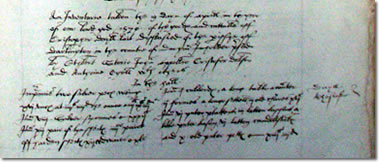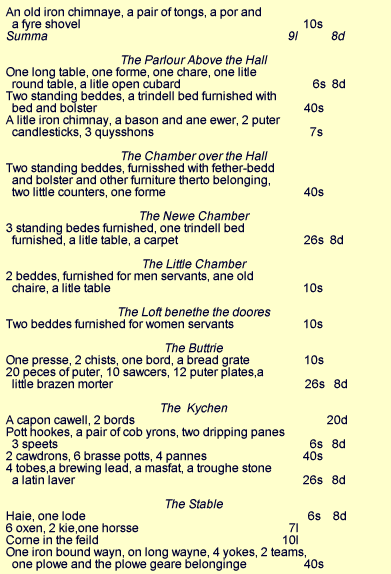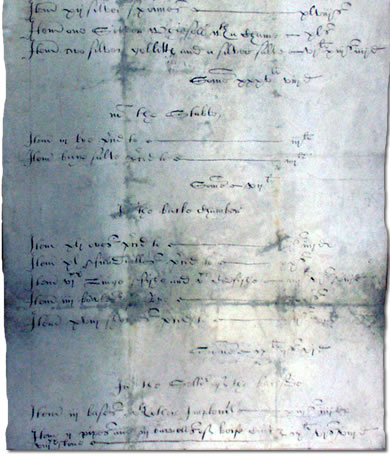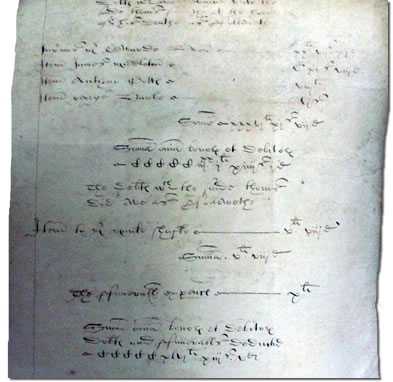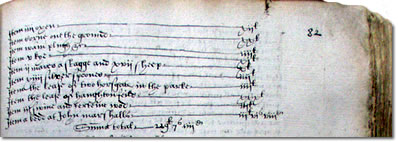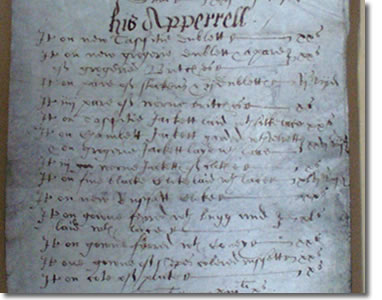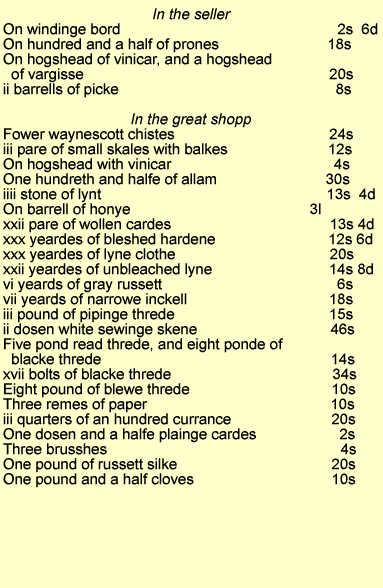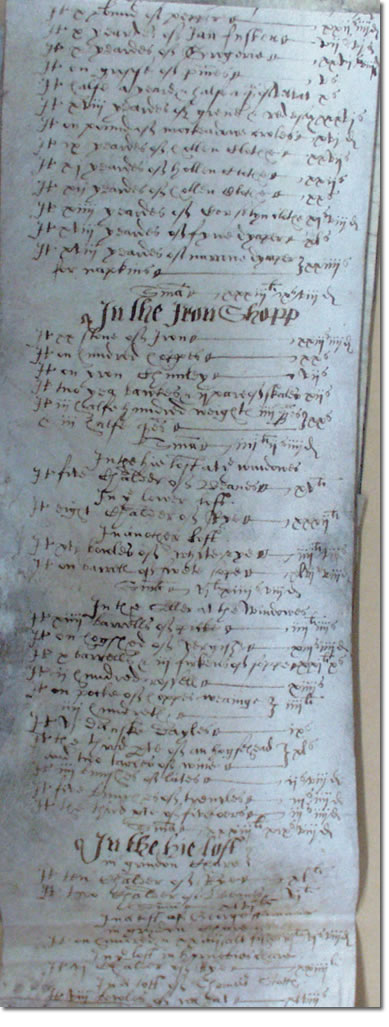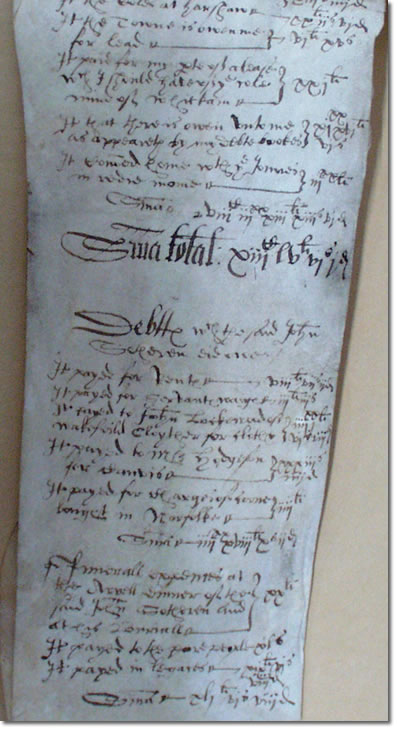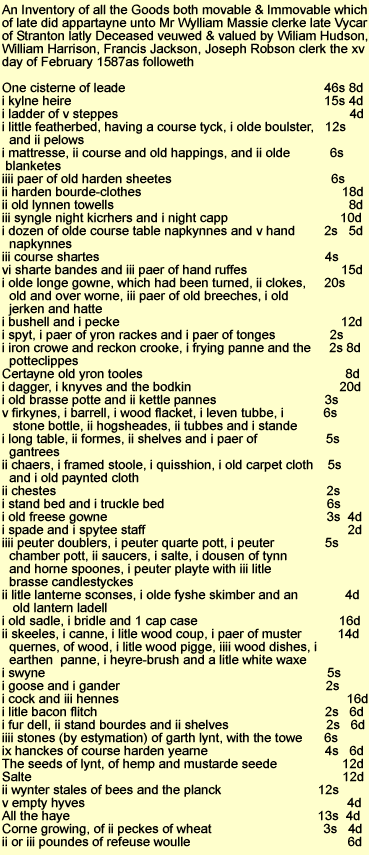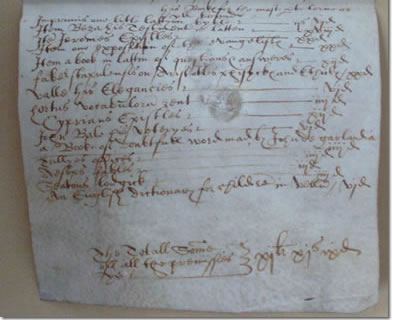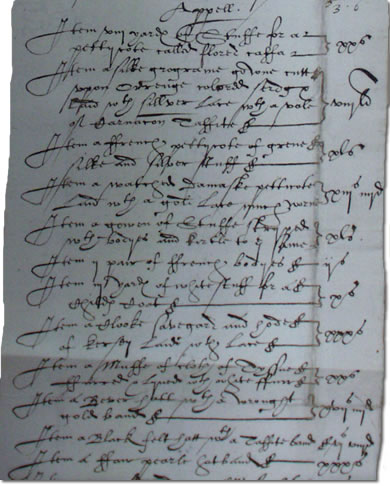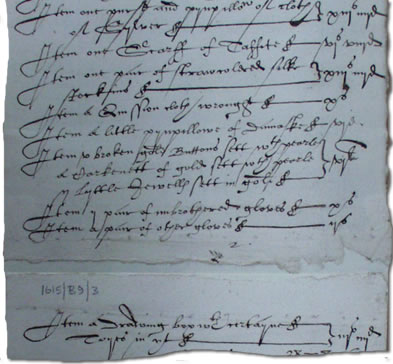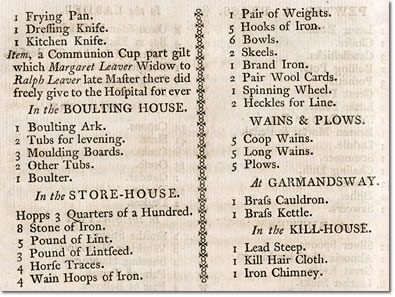
List of inventoriesWe have selected a number of different inventories from our records for you to have a look at. There are inventories of men and women, merchants and traders, farmers, a knight of the realm, and members of the clergy. Just pick one you think might be interesting and see what you can find out. Don’t forget to use the transcripts, translations and glossary if you get stuck. Source 1Extracts from the inventory of John Fenwick, gentleman. His inventory was dated 9 August 1581.
What can this inventory tell us about the life of John Fenwick? Will we be able to tell how rich he was? Take a look at the questions below to help you decide. You might find it useful to make notes on the worksheet. Let’s start investigating…. 1. Before you read the inventory, take a look at how John Fenwick is described. Do you think he was very rich, rich or comfortable? (Remember that poor people didn’t have inventories.) 2. Now read the inventory- you can use the translation if you get stuck. Think about the following: 3. Now that you have read the inventory, do you think that Fenwick was very rich, rich or comfortable? Have you changed your mind? 4. Does this inventory tell us anything else about life in Tudor Times? Source 2Extracts from the inventory of Anne Hebburn, a widow. The inventory was made in 1568.
What can this inventory tell us about the life of Anne Hebburn? Will we be able to tell how rich she was? Take a look at the questions below to help you decide. You might find it useful to make notes on the worksheet. Let’s start investigating…. 1. Before you read the inventory, take a look at how Anne Hebburn is described. Do you think she was very rich, rich or comfortable? (Remember that poor people didn’t have inventories.) 2. Now read the inventory- you can use the translation if you get stuck. Think about the following: 3. Now that you have read the inventory, do you think that Anne Hebburn was very rich, rich or comfortable? Have you changed your mind? 4. Does this inventory tell us anything else about life in Tudor Times? Source 3The inventory of Christopher Dale, innkeeper. The inventory was taken on 19 April 1570.
What can this inventory tell us about the life of Christopher Dale? Will we be able to tell how rich he was? Take a look at the questions below to help you decide. You might find it useful to make notes on the worksheet. Let’s start investigating…. 1. Before you read the inventory, take a look at what Christopher Dale did for a living. Do you think he was very rich, rich or comfortable? (Remember that poor people didn’t have inventories.) 2. Now read the inventory- you can use the translation if you get stuck. Think about the following: 3. Now that you have read the inventory, do you think that Christopher Dale was very rich, rich or comfortable? Have you changed your mind? 4. Does this inventory tell us anything else about life in Tudor Times? Source 4Extracts from the inventory of Thomas Smith, a shipwright. The inventory was taken 1586/7.
What can this inventory tell us about the life of Thomas Smith? Will we be able to tell how rich he was? Take a look at the questions below to help you decide. You might find it useful to make notes on the worksheet. Let’s start investigating…. 1. Before you read the inventory, take a look at what Thomas Smith did for a living. Do you think he was very rich, rich or comfortable? (Remember that poor people didn’t have inventories.) 2. Now read the inventory- you can use the translation if you get stuck. Think about the following: 3. Now that you have read the inventory, do you think that Thomas Smith was very rich, rich or comfortable? Have you changed your mind? 4. Does this inventory tell us anything else about life in Tudor times? Source 5The inventory of Richard Glover, a yeoman. The inventory was taken on 7th January 1587/8.
What can this inventory tell us about the life of Richard Glover? Will we be able to tell how rich he was? Take a look at the questions below to help you decide. You might find it useful to make notes on the worksheet. Let’s start investigating…. 1. Before you read the inventory, take a look at what Richard Glover did for a living. Do you think he was very rich, rich or comfortable? (Remember that poor people didn’t have inventories.) 2. Now read the inventory- you can use the translation if you get stuck. Think about the following: 3. Now that you have read the inventory do you think that Richard Glover was very rich, rich or comfortable? Have you changed your mind? 4. Does this inventory tell us anything else about life in Tudor times? Source 6Extracts from the inventory of Isabelle Rood, widow of a royal Chaplain. The inventory was taken on 6 December 1582.
What can this inventory tell us about the life of Isabelle Rood? Will we be able to tell how rich she was? Take a look at the questions below to help you decide. You might find it useful to make notes on the worksheet. Let’s start investigating…. 1. Before you read the inventory, take a look at how Isabelle Rood is described. Do you think she was very rich, rich or comfortable? (Remember that poor people didn’t have inventories.) 2. Now read the inventory- you can use the translation if you get stuck. Think about the following: 3. Now that you have read the inventory do you think that Isabelle Rood was very rich, rich or comfortable? Have you changed your mind. 4. Does this inventory tell us anything else about life in Tudor times? Source 7Extracts from the inventory of John Sotheron, a merchant. The inventory was taken on 3 July 1582.
What can this inventory tell us about the life of John Sotheron? Will we be able to tell how rich he was? Take a look at the questions below to help you decide. You might find it useful to make notes on the worksheet. Let’s start investigating…. 1. Before you read the inventory, take a look at what John Sotheron did for a living? Do you think he was very rich, rich or comfortable? (Remember that poor people didn’t have inventories.) 2. Now read the inventory- you can use the translation if you get stuck. Think about the following: 3. Now that you have read the inventory do you think that John Sotheron was very rich, rich or comfortable? Have you changed your mind? 4. Does this inventory tell us anything else about life in Tudor times? Source 8The inventory of William Massie, a Vicar. The inventory was taken on 15 February 1587/8.
What can this inventory tell us about the life of John Sotheron? Will we be able to tell how rich he was? Take a look at the questions below to help you decide. You might find it useful to make notes on the worksheet. Let’s start investigating…. 1. Before you read the inventory, take a look at what John Sotheron did for a living? Do you think he was very rich, rich or comfortable? (Remember that poor people didn’t have inventories.) 2. Now read the inventory- you can use the translation if you get stuck. Think about the following: 3. Now that you have read the inventory do you think that John Sotheron was very rich, rich or comfortable? Have you changed your mind? 4. Does this inventory tell us anything else about life in Tudor times? Source 9Extracts from the inventory of Mary Bunny, a widow. The inventory was made on 28 January 1615/16.
Source 10The inventory of the stock of cattle, plate and household goods belonging to Sherburn Hospital. The inventory is dated 24th September 1636.
What can this inventory tell us about an institution such as Sherburn Hospital? Will it tell us anything about Tudor life? Take a look at the questions below to help you decide. You might find it useful to make notes on the worksheet. Let’s start investigating…. 1. Before you read the inventory, think about what kind of things you might expect to find listed in the inventory of a hospital. You don’t need to be too specific. 2. Now read the inventory – you can use the translation if you get stuck. 3. Now that you have read the inventory, is there anything that surprised you about it? 4. Does this inventory tell us anything else about life in Tudor Times? |






